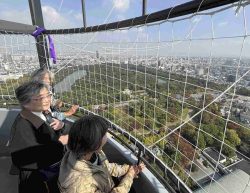
Yuzuru Yamamoto demonstrates his bouldering skills by climbing Smiling Rock at Mt. Ojigatake in Tamano, Okayama Prefecture, with a sweeping view of the Seto Inland Sea in the background.
11:24 JST, January 21, 2023
TAMANO, Okayama — Bouldering, in which climbers use their hands and feet to climb rocks and walls without a harness or tools, was added as a new sport for the Tokyo Olympics that were held in 2021, but it got its start on natural rocks.
Mt. Ojigatake, rich in oddly shaped rocks and huge boulders in Tamano, Okayama Prefecture, is said to have contributed to the spread of the sport in Japan.
On Nov. 5, the sky was blue as far as the eye could see. Yuzuru Yamamoto, 67, from Kurashiki, in the prefecture, demonstrated his bouldering skills by climbing the so-called Smiling Rock, a symbol of the 234-meter-high mountain. The rock was named for its three prominent cracks, which resemble a smiling face. Yamamoto has practiced bouldering for nearly 50 years.
The rock is about 9 meters high. Thick mats are placed on the ground to prevent injuries in the event of a fall. Yamamoto has climbed the rock many times, but he said it has never been easy.
How easy it is to slip off or grasp onto rocks varies depending on the weather and the season. Yamamoto moved up carefully, exploring the hollows and ledges with his hands and feet. It took him about five minutes to reach the top.
“I want to keep climbing as long as I’m healthy, no matter how old I get,” he said with a smile.
Only hands and feet
Yamamoto was a member of a mountaineering club when he was in high school and devoted himself to aid climbing, a style of climbing cliffs using artificial tools, for example with hooks driven into the rock walls. Around that time, bouldering was just startig to be introduced to Japan from overseas.
Two years after graduating from high school, Yamamoto visited this mountain after an acquaintance who was a mountaineering enthusiast introduced the place to him, and that is how he took to bouldering.
“I could confront rocks using only my hands and feet. That was appealing to me,” he said. “I immediately thought it would help me grow as a person.”
At the time, there were only about 100 boulderers in the entire country, he said.
“There are various rocks here that can be enjoyed by beginners and experts alike, and the ground is flat, so you are less likely to get injured,” Yamamoto said. “I think everyone who started bouldering around the same time as me has visited here at least once.”
Mt. Ojigatake straddles Tamano and Kurashiki, but its main rocky area is situated in Tamano. On Nov. 5, several enthusiasts were bouldering, while some families with children were enjoying the spectacular view of the Seto Inland Sea and rocks.
“I want people to visit this area,” Yamamoto said. “If you climb the rocks, make sure you take safety precautions.”
Revitalizing area
On the same day, an event to promote Mt. Ojigatake as a “sacred place for bouldering” was held at Uno Port in Tamano, about 7 kilometers northeast of the mountain.

Children try bouldering during an event to promote Mt. Ojigatake at Uno Port.
Hideyuki Okamoto, a 43-year-old movie producer from the city, launched an initiative in 2018 to hold such events once or twice a year in an effort to revitalize the area. During the event, a bouldering class was offered using an artificial wall, where children tried their hand at the sport.
“It feels like Mt. Ojigatake has gradually gained recognition,” Okamoto said.
According to Yasushi Takechi, 52, a curator at the Kurashiki Museum of Natural History, the oddly shaped rocks on the mountain are granite that was formed 80 million years ago as magma slowly cooled and hardened deep underground.
“The rocks were formed through gradual upheaval, erosion and weathering over an unfathomably long period of time,” Takechi said.
In the long history of the Earth, these rocks will be in their current form for only a brief moment. The mountain provides people with an opportunity to enjoy such a miraculous moment immersively, with their entire bodies.
Extend your trip!
Shibukawa Beach

Shibukawa Beach
This is the largest beach in Okayama Prefecture, boasting a coastline of white sand and green pines. It has been selected as one of the 100 best beaches in Japan, and also attracts many tourists for marine sports, such as sailing and windsurfing. The beach was closed to the public in 2020 and 2021 due to the novel coronavirus pandemic, but was reopened in the summer of 2022.
How to get there

To get to Mt. Ojigatake, take an express bus from JR Uno Station or Okayama Station and get off at the Shibukawa stop. From there, it is about a 10-minute ride by taxi, or about a 60-minute walk. By car, it takes about 20 minutes from the Kojima Interchange on the Seto-Chuo Expressway. A free parking lot for about 200 cars is located near the mountain’s summit.
Related Tags
"Features" POPULAR ARTICLE
-

Sanrio to Open Museum in Yamanashi Pref. Dedicated to Founder, Exhibits Include Hello Kitty, Other Characters
-

Autumn Foliage Surrounds Visitors to Tokyo’s Showa Kinen Park
-

My Daughter No Longer Speaks to Me, But I Want to See Her and My Grandchild
-

Kumamoto: Public Bath Refurbished as Library Where You Can Chat, Take Photos
-

Frozen Vegetables: Demand Rises for Convenient, Tasty Domestic Produce
JN ACCESS RANKING
-

Keidanren Chairman Yoshinobu Tsutsui Visits Kashiwazaki-Kariwa Nuclear Power Plant; Inspects New Emergency Safety System
-

Tokyo Economic Security Forum to Hold Inaugural Meeting Amid Tense Global Environment
-

Imports of Rare Earths from China Facing Delays, May Be Caused by Deterioration of Japan-China Relations
-

University of Tokyo Professor Discusses Japanese Economic Security in Interview Ahead of Forum
-

Japan Pulls out of Vietnam Nuclear Project, Complicating Hanoi’s Power Plans

























